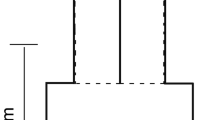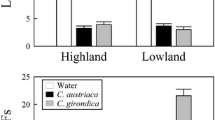Abstract
When placed in aY-maze, the 1–10-day-old free-swimming fry of the Midas cichlid can chemically distinguish between their mother and plain water and between another mother and plain water. They do not distinguish between the two mothers offered together or between their father and plain water. Predation pressures make these responses adaptive.
Similar content being viewed by others
References
Barlow, G.W. 1976. The midas cichlid in Nicaragua. Pages 333–358, in T.B. Thorson (ed.),Investigations of the ichthyofauna of Nicaraguan lakes. University of Nebraska, Lincoln, Nebraska.
Brichard, P. 1975. Réflexions sur le choix de la nidification ou de l'incubation buccale comme mode de reproduction chez certaines populations de poissons Cichlides du lac Tanganyika.Rev. Zool. Afr. 89:871–888.
Caprona, D.C. 1974. The effect of chemical stimuli from conspecifics on the behavior ofHaplochromis burtoni (Cichlidae, Pisces).Experientia 30:1394–1395.
Cole, J.E., andWard, J.A. 1970. An analysis of parental recognition by the young of the cichlid fish,Etroplus maculatus (Bloch).Z. Tierpsychol. 27:156–176.
Cole, L.C. 1962. A closed sequential test design for toleration experiments.Ecology 43:749–753.
Fryer, G., andIles, T.D. 1972.The cichlid fishes of the Great Lakes of Africa: Their biology and evolution. Oliver and Boyd, Edinburgh.
Hay, T. 1976.Effects of age and experience on responses of Cichlasoma nigrofasciatumfry to parents and predators (Pisces:Cichlidae). Ph.D. thesis, University of California, Berkeley, California.
Kuenzer, P. 1968. Die Auslösung der Nachfolgereaktion bei erfahrungslosen Jungfischen vonNannacara anomala (Cichlidae).Z. Tierpsychol. 25:257–314.
Kühme, W. 1963. Chemisch ausgeloste Brutpflege- und Schwarmreaktion beiHemichromis bimaculatus (Pisces).Z. Tierpsychol. 20:688–704.
Little, E.E. 1975. Chemical communication in maternal behaviour of crayfish.Nature 255:400–401.
McKaye, K.R. andMcKaye, K. 1977. Communal care and kidnapping of young by parental cichlids.Evolution (in press).
McKaye, K.R., andBarlow, G.W. 1976. Chemical recognition of the young by the midas cichlidCichlasoma citrinellum. Copeia (2):276–282.
McKaye, K.R., andHallacher, L.E. 1973. The midas cichlid in Nicaragua.Pac. Discovery 26:1–8.
Myrberg, A.A. 1966. Parental recognition of the young in cichlid fishes.Anim. Behav. 14:565–571.
Myrberg, A.A. 1975. The role of chemical and visual stimuli in the preferential discrimination of young by the cichlid fishCichlasoma nigrofasciatum (Günther).Z. Tierpsychol. 37:274–297.
Noakes, D.L.G., andBarlow, G.W. 1973. Ontogeny of parent-contacting in youngCichlasoma citrinellum (Pisces:Cichlidae).Behaviour 46:221–255.
Noble, C.K. andCurtis, B. 1939. The social behavior of the jewel fishHemichromis bimaculatus Gill.Am. Mus. Nat. Hist. Bull. 76:1–46.
Russock, H.I., andSchein M.W. 1974. Effect of early experience and age on initial responsiveness ofTilapia mossambica fry to a maternal model.Anim. Learn. Behav. 2:111–114.
Author information
Authors and Affiliations
Rights and permissions
About this article
Cite this article
Barnett, C. Chemical recognition of the mother by the young of the cichlid fish,Cichlasoma citrinellum . J Chem Ecol 3, 461–466 (1977). https://doi.org/10.1007/BF00988188
Received:
Revised:
Issue Date:
DOI: https://doi.org/10.1007/BF00988188




